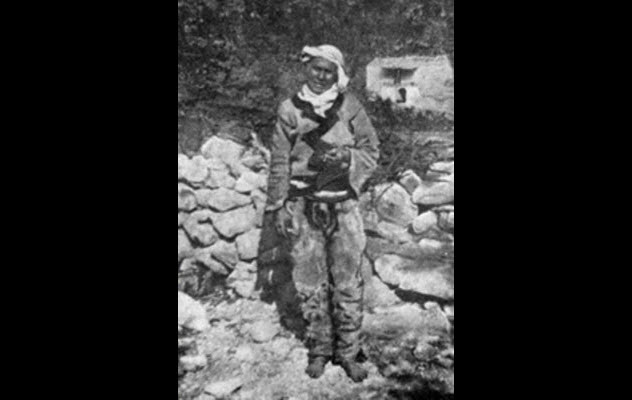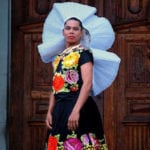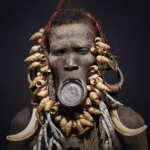 Mysteries
Mysteries  Mysteries
Mysteries  History
History 10 Surprising Stories About the Texas Rangers
 Humans
Humans 10 Philosophers Who Were Driven Mad by Their Own Theories
 Miscellaneous
Miscellaneous 10 Video-Game-Worthy Weapons and Armors from History
 Weird Stuff
Weird Stuff 10 Psychics Who Accurately Predicted Wartime Events
 The Arts
The Arts 10 Pieces of Art Inspired by a Broken Heart
 Health
Health 10 Science Fiction-Sounding New Medical Treatments
 History
History 10 Surprising Facts About the Father of Submarine Warfare
 Space
Space Ten Astonishing New Insights into Alien Worlds
 Weird Stuff
Weird Stuff 10 Bizarre Summer Solstice Rituals Still Practiced Today
 Mysteries
Mysteries Top 10 Haunting Facts About the Ghost Ship MV Alta
 History
History 10 Surprising Stories About the Texas Rangers
 Humans
Humans 10 Philosophers Who Were Driven Mad by Their Own Theories
Who's Behind Listverse?

Jamie Frater
Head Editor
Jamie founded Listverse due to an insatiable desire to share fascinating, obscure, and bizarre facts. He has been a guest speaker on numerous national radio and television stations and is a five time published author.
More About Us Miscellaneous
Miscellaneous 10 Video-Game-Worthy Weapons and Armors from History
 Weird Stuff
Weird Stuff 10 Psychics Who Accurately Predicted Wartime Events
 The Arts
The Arts 10 Pieces of Art Inspired by a Broken Heart
 Health
Health 10 Science Fiction-Sounding New Medical Treatments
 History
History 10 Surprising Facts About the Father of Submarine Warfare
 Space
Space Ten Astonishing New Insights into Alien Worlds
 Weird Stuff
Weird Stuff 10 Bizarre Summer Solstice Rituals Still Practiced Today
10 Examples Of Nonbinary Genders Throughout History
With the revitalized interest in transgender and nonbinary folks because of Caitlyn Jenner’s coming-out, people seem to forget that these issues have been around since the beginning of human history. There have always been cultures with people who do not fit only into “male” or “female” categories and need a more accurate description of their genders.
10The Five Genders Of Sulawesi, Indonesia

Sulawesi is a small island that is part of Indonesia, usually known for paradise beaches and leisurely vacations. It is also a place with radical views on gender and sex in their people. The Bugis (or “Buginese people”) of Sulawesi recognize four genders and an important fifth “metagender.”
The first two genders are male and female, but the next two are the calalai and calabai. The calalai are anatomical females who behave as men traditionally do, but they do not desire to be men. They fall into a gray area between the two sexes. An example of a calalai might be an anatomical female who works as a mechanic, wears men’s clothing, and lives in a way that is typical of a man.
In contrast, the calabai are anatomical males who behave as women traditionally do. But while the calalai largely conform to the roles of men, the calabai do not consider themselves to be women. They don’t accept the restrictions that society places on women, either. Instead, the calabai have a unique niche in society. For example, weddings are an extravagant affair in Sulawesi culture, and the calabai are usually the brains behind the operation.
The “metagender” of the Sulawesi people is known as the bissu. Bissu (pictured above) are seen as a combination of all genders. They have a distinctive way of dressing that is neither “male” nor “female,” and they also have their own specific roles in society. A bissu functions as a sort of shaman or priest who leads spiritual rituals for others, which is an important and coveted role in Sulawesi life. They are seen as beings who “bestow blessings” upon others who are not as attuned to the spirit world.
In fact, the bissu are so important in Sulawesi culture that they play central roles in Sulawesi creation stories. In one ancient tale describing the birth of the first human on Earth, a bissu was the key figure who aided the parents in finding each other. To become a bissu, a person must be born a hermaphrodite.
9The Hijras Of India

Hijra is a third gender in India that has been around for thousands of years. Hindu hijras were mentioned in ancient epic stories, and Muslim hijras were once the guards of mosques. Their important place in Indian history can’t be ignored.
Hijras are males who take on traditional female roles and expectations, but they occupy their own territory as a third gender. They have their own culture and roles in society that are beyond “male” or “female.” For example, to bestow good fortune, hijras dance at weddings and play an important role with newborns.
Acting as a sort of spiritual bargainer, hijras go to houses with newborns, bless them, and ask for payment from the family. Sometimes, a hijra won’t leave the home until the family pays them. However, there usually isn’t a problem because upsetting a hijra is rumored to curse the infant.
Becoming a hijra is not an easy process. Aspiring hijras give all their money to a guru in return for guidance and a place to live during the transition. Then the individual must go through a number of rituals and procedures that range from spiritual ceremonies to feminization surgeries like castration. One hijra noted that they couldn’t work for a couple months after a painful castration but said it was worth it to become “a beautiful butterfly.”
Discrimination against hijras is widespread. They are often turned away from hospitals and employers and forced to become sex workers or beggars. However, a 2014 legal victory made the hijras officially recognized by law as a third gender in Indian society.
8The Kocek Of The Ottoman Empire

In Turkey, dancing was a revered art form during the Ottoman Empire. People spent a lot of money to attend dance performances, including an infamous dance style performed by the kocek. The kocek were men who dressed in feminine clothing and performed exotic dances for audiences throughout the empire. Some of the kocek were amateurs, and some were even slaves. But many were professional, popular, and highly paid.
Despite their gender-bending appearances and feminine dance moves, the kocek were not trying to impersonate females. Instead, they were a third gender, who embraced both their masculine and feminine features.
Although kocek performances sometimes ended in “glass-breaking and . . . dagger-brandishing,” many individuals (mostly adult males) saw the kocek dancers as serious objects of desire. The kocek were known to be sexually adventurous and were often courted by men.
Although the kocek began as respected and elite members of society, their scandalous lifestyles eventually became too much for some people to accept. In 1857, kocek dancing was outlawed, with widespread disapproval extending to the kocek lifestyle. After that, the dance and lifestyle only persisted in small areas of the empire.
7The Muxes In Mexico
In many parts of rural Mexico, gay bashing and homophobia are common. However, the Zapotec in Oaxaca have always been more tolerant of non-straight and nonbinary identities. In fact, they recognize a third gender beyond male and female: muxes.
Muxes are men who choose feminine appearances. The word is derived from mujer, which means “woman.” A crucial role of muxes is to take care of their parents when they get older because sons and daughters are more likely to get married and have families of their own.
Anthropologists trace the roots of muxes to pre-Colombian Mexico when there were transvestite Aztecan priests and androgynous Mayan gods. A third gender has long been a part of life in this area of Mexico.
Every year in Oaxaca, there is a flashy festival called Vela de Las Intrepidas (“The Vigil of the Intrepid“), where thousands of muxes meet for a parade and other ceremonies. Even some Catholic priests get involved, which truly demonstrates how accepted muxes are. Apparently, the event started almost 40 years ago with just a handful of muxe friends, but over the years, it grew into a massive party.
6The Two-Spirited People Of North America

Although the Europeans who came to North America were largely homophobic and intolerant of nonbinary people, Native Americans have always recognized a third gender called “two-spirited people.” In fact, two-spirited people were revered by at least 155 tribes across North America as healers, caregivers, nannies of orphans, and visionaries.
But they weren’t deemed “two-spirited” simply because of their appearance. They were truly thought to have the spirit of both a man and a woman, which gave them abilities beyond those of “regular” men and women. Two-spirited people can be men who dress as women, women who dress as men, androgynous folks, and so on. The term encompasses many identities outside of “male” or “female.”
There were many native rituals and ceremonies that helped to determine if a child was truly two-spirited. In one ritual, a child was placed in the middle of a circle where adults sang songs. If the child started to dance in a feminine manner and continued for at least four songs, the child would be deemed “two-spirit.”
As European influence grew and many Native Americans were introduced to Christianity, respect for two-spirited people gradually decreased, and Christian homophobia began to take its place. However, in the past few decades, there has been a resurgence of interest in and respect for two-spirited people, and today there are gatherings for people who identify as this third gender.
5The Kathoeys Of Thailand

While many of the third-gendered people on this list are not commonly known, the kathoeys (or “ladyboys”) of Thailand are often mentioned in pop culture. Kathoeys range from occasional cross-dressers to transsexuals, and they are seen as a third category of gender identity. They are so common in Thai society that a poll at one school revealed that 10 percent of its students identified as kathoey.
Throughout Thailand, kathoeys work in regular jobs, pop culture and media, and the thriving sex tourism industry as sex workers. However, kathoeys still face a lot of stigma and obstacles. Many people think they should stay in the sex industry, and some employers refuse to hire them. In addition, kathoeys have not received full legal recognition. A man who transitions to a woman still has to identify as a man on identification.
Although they are a modern pop culture sensation, kathoeys have existed for a long time. In a 15th-century Thai creation myth, two hermaphrodite characters are central to the story, and the myth actually mentions men, women, and a third gender category. Throughout Thai history, kathoeys have been an important part of the culture, even if they’ve faced certain obstacles because of their identities.
4The Warias Of Indonesia
Many people are surprised that there is a third gender called warias in Indonesia, a largely Muslim nation with many conservative values. Warias can be males who feel like they should be women, cross-dressers, people who believe they are truly a third gender, and more. The word comes from a combination of wanita, which means “woman,” and pria, which means “man.”
Muslim beliefs, which state that there are only male and female genders, dominate Indonesian life. As a result, warias face widespread discrimination in Indonesian society. For example, they can’t pray at most mosques, even though many warias are Muslims. So there are mosques just for the waria community.
In addition, most warias become sex workers or entertainers because there are no other employment options for them. For some warias who appear to be women, their IDs still claim they are men, so many employers won’t hire them.
Despite this discrimination, every year there is a large “Miss Waria Indonesia” pageant and festival with a beauty competition, educational events, music, and more. Many warias enter the beauty pageant. They are judged in a number of categories as they compete to be voted “Miss Waria Indonesia” and named as a positive role model for the community.
The event has been subjected to protests and negative criticism but has slowly become more accepted. One of Thailand’s former presidents actually attended in 2006, which was an important symbol for the community.
3The Mahus Of Hawaii
In beautiful Hawaii, there has long been a tradition of a third gender of people named the mahu who fall somewhere between “male” and “female.” Mahus had their own roles in society and were respected as healers, teachers, and caretakers. Through the generations, they passed down knowledge on hula, songs, chants, and other Hawaiian wisdom. One reflection of the mahu people is evident in Hawaiian music, which often displays love stories that don’t conform to traditional Western gender norms.
When Christian missionaries arrived in Hawaii, they were shocked by Hawaiian society, including the mahus, and tried to condemn their traditional practices. As a result, Hawaiian society became less tolerant of the mahus.
However, in recent years, Hawaii has experienced a resurgence in mahu traditions and become more tolerant again. A documentary came out in 2015 called Kumu Hina, which follows Hina, a mahu in Hawaii who teaches youth about Hawaiian culture. In one of her classes, a young girl wants to lead the all-male hula troupe, and Hina accepts the girl as a mahu and allows her to do so.
2The Sworn Virgins Of The Balkans

In the Balkan region of Albania, “sworn virgins”—women who swear to live as virgins for their entire lives—take on a more traditional male role in the community. Sworn virgins had an interesting beginning. Sometimes in battles, a family would lose all of its men, so a woman would assume the role of patriarch. This tradition can be traced back to the 15th-century Kanun, a tribal code of law from that time.
Although the prospect of being a virgin for the rest of one’s life can be daunting for many, sworn virgins were respected and proud. After one researcher had interviewed a number of sworn virgins, he claimed that none had any regrets about their lifestyle decision.
While many sworn virgins were women trying to pass as men, some were more “in between,” appearing to be neither male nor female. Today, the sworn virgin phenomenon is much less common, but there are still a small number of them living in the Balkans.
1The Modern Genderqueer Movement
In today’s world, the word “genderqueer” has become a form of identity for many people who feel frustrated by a gender binary system. This expression was created in the 1990s as an umbrella term for anyone who felt that they fell outside of strict “male” or “female” categories. The genderqueer movement grew tremendously because of the Internet, and today, many people prefer to identify as “genderqueer” rather than “male,” “female,” “transgender,” or something else.
Many genderqueer people prefer to use pronouns like “they” or “them” instead of “him” or “her.” Some schools and institutions are even beginning to accept alternative pronouns for individuals. For example, Harvard University recently added a “preferred pronouns” section on their registration form, which includes options like the gender-neutral “ze” or “they.” Less progressive places, though, are not as open to genderqueer identities. The University of Tennessee posted an article about gender-neutral pronouns on its website but took it down after senators complained.
The genderqueer movement appears to be picking up speed. In 2015, even pop culture sensation Miley Cyrus told the world that she felt like a third gender.
I am a dude from New Hampshire who likes music, the Internet, and new experiences.








